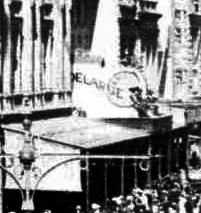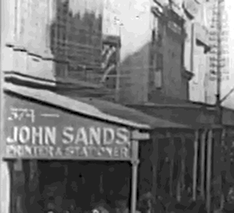Tram ride along George Street, Sydney in 1907
One of the surviving Australian motion pictures from the beginning of the 20th century was taken from the roof of an electric tram as it travelled south along a northern section of George Street, Sydney, New South Wales, Australia. The film shows life on a main city street in the afternoon, though it is not known if it was on a weekday or a weekend day. Other than the trams the vehicular traffic seen is all horse-drawn. Early on a bicyclist manages to keep pace ahead of the tram. The tram from which the film was shot has a clear run, staying well behind the tram in front; this contrasts with the many trams travelling in the opposite direction (north).
The National Film and Sound Archive of Australia holds two versions of the film, copies of which are contained in various collections with other film items. One version has the title
A 1906 BIRD'S EYE VIEWbut this is missing the several seconds as the tram passes the west end of Martin Place and the Sydney General Post Office; the other, untitled version includes this view.1 How there came to be these two versions is not known, nor why the date of 1906 was given to them.
OF GEORGE STREET
Cameraman takes his life in his hands in perilous trip _ Whoopee!
Various copies of the film are also accessible on YouTube;
these are mostly of indifferent quality, usually being cropped or with
their aspect ratio altered.
Those with the section at Martin Place and the GPO are
https://www.youtube.com/watch?v=nYGubNbEmhc,
https://www.youtube.com/watch?v=lHFR9Zsp33w, and
https://www.youtube.com/watch?v=YHkzuyWpoLk;
those without are
https://www.youtube.com/watch?v=j6DvqIIWAcY and
https://www.youtube.com/watch?v=e9YUSKx2WPE.
The intrepid cameraman and his camera must have been well fastened to the roof of the tram, for he uses one hand to crank the camera and the other to make occasional pans.
When was the film shot?
There are two obvious things seen in the film that enable the date when it was taken to be restricted to a small range of years. The first is the electric tram that moves eastward (right to left) on King Street about midway through the film. The King St electric tram service (replacing the cable tram) commenced on 15 January 1905, although there had been trial runs previous to this.2
A later bound on the date of filming was that of the removal from George St of the centre T-posts that carried the trolley wires that provided the electricity for the trams. This work was commenced in mid-October 1907,3 and the posts from the section of tramway between Circular Quay and King St were reported to have been removed by 15 January 1908.4 But there is no sign in the film of the replacement system, where the trolley wires were supported by wires between opposite buildings, or occasionally by poles in the footpaths, so it is almost certain that the film was taken before the end of 1907.
However, the clincher for narrowing the date range is something that isn't seen: the Delarue clock that used to be atop the awning over the footpath at 378 George St, two doors south of John Sands' premises, whose shop sign is prominent as the tram passes Martin Place and the General Post Office.
 Now you see it ...
|  ... now you don't
|
The image on the left is a detail from a photograph that was taken on 6 May 19045 and shows a somewhat retouched view of the clock (with one or two persons sitting next to it); the image on the right is a detail from a frame of the film.
The latest Sydney telephone directory that carried an entry for H. F. Delarue & Co., jewellers, at 378 George Street was that for September 1907; they weren't listed in the December 1907 edition.
On 20 February 1908 Sydney's The Bulletin published a short article6 that commences with:
The removal of Delarue's clock, with the blackfellow striker, which timepiece has faced all weathers in George-street, Sydney, for 40 years, recalls the fact that ...But the taking down of the clock must have occurred weeks earlier (although no prior mention of it has been found). An auction of the whole of Delarue's stock-in-trade and shop fittings was advertised to take place on 30 April 1907.7 It appears that most or all of this was bought by Diamond Brothers, because they then held auctions of Delarue's stock on 15, 16, and 17 January 1908, at the store at 378 George St.8 One of the items specifically listed for sale was a
Clock, for Town Hall or public building, by Collin, successor to Wagner, Rue de Montmatre, [sic] Paris.It is tempting to think that this clock was the one that had been on the awning outside the shop; presumably it had been taken down by the time of the auction.
There is (at least) one other detail that sets the year of filming at 1907. At the start of the film, in the top left of the frame, a large sign for "EASTWAY'S" can be seen on the side of a tall building. Eastway Brothers had a new 7-storey building constructed for them at 330-332 George St, work being underway in November 1906, and the company moving in in early May 1907.9
Analysis of the lengths of shadows in the film and the heights of their respective objects, and of the angles of these shadows with respect to the direction of north, enables the position of the Sun at the time of filming to be estimated. Although the accuracy of these measurements is considerably limited by the quality of the film copies available and by not knowing the specifications of the camera and its lens, they do indicate that the cinematography was done between the (southern) spring equinox (i.e. roughly 22 September 1907) and the following autumn equinox (i.e. about 22 March 1908).
From the available evidence and the above analysis it is almost certain that the film of the George St tram journey was taken in the last 3 months of 1907.
References and notes
[1] The titled version is NFSA no. 106667. This is the third segment of NFSA no. 45573, which consists of items from the Pearson collection. It should be noted that the textual titles of the segments are facetious, and are almost certainly not contemporary with the respective film content. The untitled version of the film is part of NFSA no's 34970, 45573, 47890, 65162, and 395613.
[2] 25 January 1905, The Sydney Mail, p.220, Last of the tram cable service.
[3] 17 October 1907,
The Sydney Morning Herald, p.6, Tramway Poles.
17 October 1907,
Daily Telegraph (Sydney), p.7b, Tram Traffic Improvements.
[4] 15 January 1908,
The Sydney Morning Herald, p.8, Removing the Centre Poles.
15 January 1908,
Daily Telegraph, p.14a, Since the poles were removed.
[5] 11 May 1904,
The Sydney Mail, p.1181, Official Visit of the Governor-General to New South Wales.
(Image courtesy of the National Library of Australia.)
This is the latest known dateable photograph that shows the Delarue clock.
The National Library of Australia also has a photograph of the
General Post Office, Sydney, ...
that is contemporary with the film because the Delarue clock is gone but
the tram posts are still there;
unfortunately this image is not accurately dated.
[6] 20 February 1908,
The Bulletin (Sydney), p.13a, at the bottom of the column.
The article was repeated almost verbatim at
28 February 1908,
Lithgow Mercury (Lithgow, NSW), p.8g, Items of Interest.
[7] 25 April 1907, The Daily Telegraph, p.2f, Auctions.
[8] 11 January 1908,
The Sydney Morning Herald, p.22a, Auction Sales., Delarue's Stock.
16 January 1908,
The Sydney Morning Herald, p.11g, Auction Sales., Continuation Sale., Delarue's Stock.
17 January 1908,
The Sydney Morning Herald, p.2f, Auction Sales., Continuation Sale., Balance of Delarue's Stock.
[9] 27 October 1906,
Daily Telegraph, p.18f, Building and Construction.
7 May 1907,
The Sydney Morning Herald, p.11b, Buildings and Works., Progress of the Trade., Eastway Brothers' Premises.
|
Copyright © 2022 Tony Martin-Jones | FILM HISTORY INDEX |
Edition 1 (2022-06-06) |